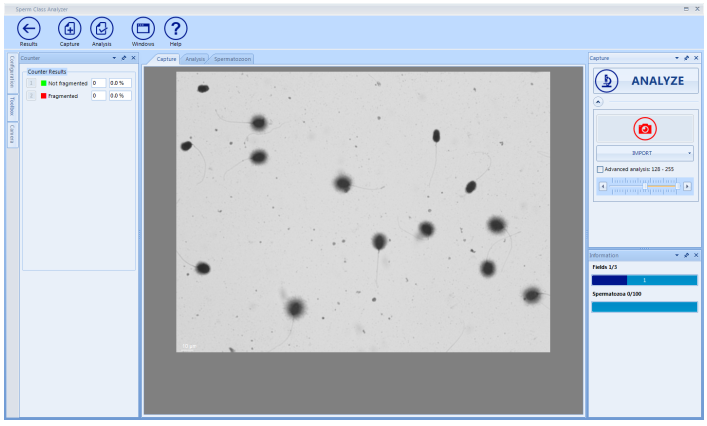SCA is firstly a top class Computer Aided Semen Analysis System: But it has many other applications. What are these?
The Sperm Class Analyzer (SCA) of Microptic S.L. needs no introduction and has earned a reputation as the most advanced CASA system providing the widest range of modules to analyse many facets of sperm characteristics and functionality. In this context sperm quality and sperm functionality of human sperm and sperm of most animal species can be analysed objectively. Some of these facets include sperm concentration, many aspects of sperm motility (including mucous penetration and hyperactivation), sperm morphology (including sperm indices such as TZI, MAI and DI) vitality, sperm fragmentation, acrosome reaction and peroxidase positive leukocytes (SCA 6.4 to be released). All these aspects can be measured in a very short time using the SCA.

So while the SCA system is a dedicated system for automated/quantitative sperm analysis in the human, veterinary or research environment, does it have other applications?
1.- The SCA Manual counter module which is usually provided free of charge if you purchase the basic SCA system: With the Manual counter it is possible to do semi-quantitative analysis of almost any aspect of spermatology as captured with routine or specialized microscopy. These include for example your own morphology, vitality and fragmentation preparations and you can even make your own user defined analysis. You can allocate what is normal/abnormal/ for any analyses and save these files together with the bitmap images to show in semi-quantitative way your results. Imagine during normal manual analysis there is no proof.
2.- Use SCA as an important measurement tool. One can capture any pictures in the Motility or Morphology module and by using the Toolbox it is possible to measure many aspects such as length, width, perimeter, area and many more. Picture below shows helical swimming sperm motility tracks of sea urchin sperm and it is possible to use the SCA measurement tool to quantify many aspects such as the diameter of the helical track (relates to speed for example).

Helical swimming tracks to show how the SCA measurement tool can be used to measure the diameter of the helix. Here it could be related to swimming speed. The larger the helix diameter the higher the speed of the sperm.
3.- Recording high quality pictures of sperm morphology for publications. In this picture NDIC technique has been used but it could well be stained sperm, or using phase contrast microscopy or any other microscopy technique:

Nomarski differential interference contrast (NDIC) microscopy of sea-urchin sperm as captured with Basler ACA 1300-200uc camera in Morphology module of SCA (no analyse mode).
4.- In the IVF lab one can either directly capture or use imported bmp files of different quality oocytes and develop their own classification system for different quality oocytes. The value is that this database of oocyte pictures with classification can serve as quality control for oocyte morphology for IVF purposes and furthermore be used for training embryologists.
5.- Any bmp file of even electron micrographs can be imported for counting and or measurement of cell organelles inside a sperm cell. A good example will suffice. The number of mitochondria in a sperm cell is species specific but even then there may be a deficit. For example, in human sperm there are optimally 27 mitochondria but 17 may point to asthenozoospermia (reduced motility). Picture below is an example of the typical eight mitochondria found in bottlenose dolphin sperm. So in SCA Manual counter these aspects can be recorded and quantified.

The typical eight mitochondria in bottlenose dolphin as viewed with transmission electron microscopy.
There are many other possibilities to quantify various aspects of sperm or other cells with SCA in addition to its specified CASA modules.
Prof Gerhard van der Horst (PhD, PhD)
Senior Consultant
MICROPTIC S.L.




Leave A Comment